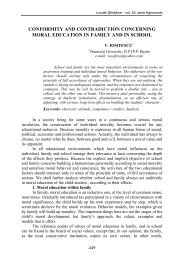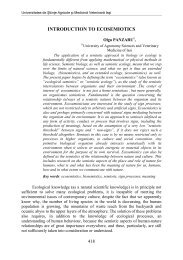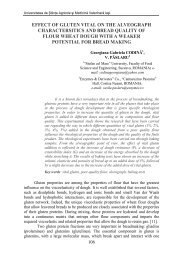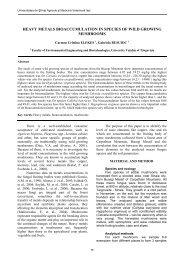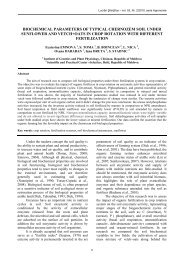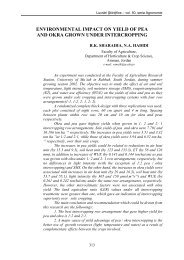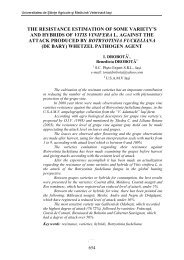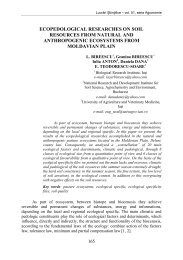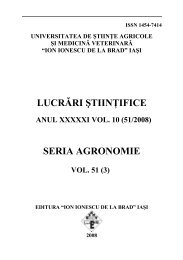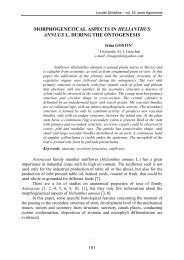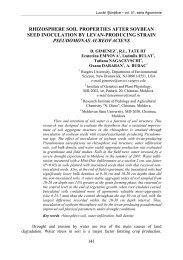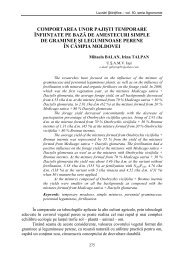THE IMPROVEMENT OF THE QUALITY OF WHEAT FLOUR WITH A ...
THE IMPROVEMENT OF THE QUALITY OF WHEAT FLOUR WITH A ...
THE IMPROVEMENT OF THE QUALITY OF WHEAT FLOUR WITH A ...
Create successful ePaper yourself
Turn your PDF publications into a flip-book with our unique Google optimized e-Paper software.
Lucrări Ştiinţifice – vol. 52, seria Agronomie<br />
<strong>THE</strong> <strong>IMPROVEMENT</strong> <strong>OF</strong> <strong>THE</strong> <strong>QUALITY</strong> <strong>OF</strong> <strong>WHEAT</strong><br />
<strong>FLOUR</strong> <strong>WITH</strong> A LOWER CONTENT <strong>OF</strong> α - AMYLASE<br />
THROUGH <strong>THE</strong> ADDITION <strong>OF</strong> DIFFERENT<br />
ENZYMATIC PRODUCTS<br />
Georgiana Gabriela CODINĂ 1 , Ana LEAHU 1<br />
1<br />
„Ştefan cel Mare” University Suceava,<br />
Food Engineering Faculty<br />
e-mail: codina@usv.ro<br />
This paper aims to outline the opportunities of use and the tendencies<br />
of improving the rheological properties of the dough obtained from flours<br />
with a low content of α-amylase induced by the addition of some enzymatic<br />
products provided by S.C. Enzymes & Derivates, Romania. The low level of<br />
α-amylase in the wheat especially supposes a supplementation of flour with<br />
this enzyme, which has two functions in the process of bread making: on the<br />
one hand, it continually provides fermentable sugars for yeast and at the<br />
same time it produces carbon dioxide, and on the other hand, it contributes<br />
to the improvement of dough properties and leads to a higher bread quality.<br />
Therefore, this paper has used four different enzymatic products, which<br />
contain α-amylase from different sources, such as malt flour and moulds such<br />
as Aspergillus oryzae. The effect of the addition induced through adding<br />
various improvers was analyzed through the value of the falling number<br />
index of the sample flour but also through the evolution of the dough<br />
rheological properties measured with the lab device Promylograph T3. As a<br />
result of the experiments carried on, it was noticed that the falling number<br />
decreases up to the optimum value of 250 seconds starting with doses of<br />
about 100g/100kg added enzymatic product. A stronger effect of optimizing<br />
the falling number was seen in the case of improvers which contain enzymes<br />
from malt flour (cereals).<br />
Key words: promylograph, falling number, α-amylase, malt flour<br />
The supplementation with amylase, which is found in insufficient quantities<br />
in flour, has a great practical importance. It is known that, in general, the flour<br />
obtained from the grain harvested mechanical or from the drought period has<br />
almost none or a very weak α-amylase activity. This kind of flours have a reduced<br />
capacity of forming fermentescibile carbohydrate and therefore of forming gas.<br />
These flours have a low maltose index (1.5-2%) and a high falling number value<br />
(over 300s) [1]. The supplementation of flour with α-amylase intensifies the<br />
amylolse and increases the quantity of fermentescibile carbohydrates from the<br />
dough, through maltose formation, capable of ensuring the formation of gas on the<br />
entire duration of the technological process, including in its the final phase, at a<br />
level which guaranties the obtaining of a quality bread.<br />
629<br />
629
Universitatea de Ştiinţe Agricole şi Medicină Veterinară Iaşi<br />
The supplementation with amilolitic preparations can be realized during the<br />
grinding of the wheat, further in the flour or during the preparation of the dough. It<br />
is realized through the addition of α-amylase or of products from malt, the<br />
preparations of fungal α-amylase and preparations of bacterial α-amylase [2, 3, 4].<br />
It was considered useful to use a series of enzymatic preparations which don’t<br />
contain only pure α-amylase, but a mixture of enzymes and additives used in<br />
bakery in order to ensure an optimal improvement of the rheological characteristics<br />
of the dough prepared from wheat flour because in the experiments it was used a<br />
flour with high fall value, but a low deformation value. Also it was used a<br />
comparative study between the enzymatic preparations which contain more<br />
ingredients in the mixture and the malt flour which present a high α-amylase<br />
activity, and important quantities of reducing sugars, specially maltose and<br />
proteolytic activity.<br />
MATERIAL AND METHOD<br />
Commercial wheat flour (harvest 2008) were milled on an experimental Buhler<br />
mill from Mopan S.A. (Suceava, Romania). Deionised water was used in all<br />
experiments. Enzyme supplementation into dough formulation meant Belpan As,<br />
Belpan MOPA and Belpan Malţ using in differnt doses, like flour improver.<br />
Enzymes@Derivates Romania Co supplied this commercial products which contain the<br />
following composition:<br />
Belpan AS contains malt diastase flour, stearoil 2 lactilat sodium, ascorbic<br />
acid, cysteine, fungal alpha amylase, fungal hemicelulază, xilanază;<br />
Belpan MOPA contains diastase malt flour, non-degreased soy flour with<br />
enzymatic activity, mono-and digliceride of fatty acids-E471, steroil-2-lactilat<br />
sodium, ascorbic acid, cysteine;<br />
Belpan Malt contains pure malt flour.<br />
Control flour was analyzed by performing Romanian standards methods: SR ISO<br />
712:1999, SR EN ISO 21415-2/2008, SR EN ISO 21415-2/2008, SR 90/2007, SR ISO<br />
3093:1997. In experiments was used a flour with 14.4% moisture, 0.64% ash content,<br />
28.7% wet gluten content, 5 mm gluten deformation, and falling number 429 s. Data<br />
acknowledge that the control flour has a average potential for bread-making from that<br />
point of view.<br />
The rheological properties of the flours were made on promylograph device for<br />
doses of 50, 100, 150 and 200 g/100kg of flour with commercial added products. The<br />
promylographical method of determination of rheological characteristics of the dough is<br />
similar with the pharinographical method of the determination of the same parameters:<br />
hydration capacity, stability, formation time, the soaking degree etc. The using of<br />
established dough formulation, the falling number performed and the α-amylase<br />
indicators where compared.<br />
630<br />
630
Lucrări Ştiinţifice – vol. 52, seria Agronomie<br />
RESULTS AND DISCUSSIONS<br />
1. The characterization of comercial products used in the improvement<br />
of white flour with a low content of α-amylase.<br />
Belpan AS contains components which improve the capacity of the dough of<br />
forming gas (malt diastasis flour, fungal alpha amylase), components which<br />
weaken the rheological properties of gluten (cysteine), components which increase<br />
the freshness of the bread (stearoil 2 lactilat of sodium), oxidation agents (ascorbic<br />
acid), components which act on the poly-carbohydrate and non starch fraction from<br />
the wheat flour (fungal hemicelulaza, xilaniza).<br />
Belpan MOPA contains components which improve the capacity of the<br />
dough of forming gas (diastasis malt flour), components which weaken the<br />
rheological properties of gluten (cysteine), components which increase the<br />
freshness of the bread (non degreased soy flour with enzymatic activity, mono and<br />
di-glycerides of fat acids – E471, steroil-2 lactilat of sodium), oxidation acids<br />
(ascorbic acids).<br />
Belpan Malt is malt flour obtained from germinated cereals in conditions<br />
which protect the enzymes. Therefore, this product contains besides α-amylase in<br />
large quantities and proteolytic enzymes, and other active at germination enzymes,<br />
products of hydrolysis of the components of the seed: maltose, dextrin, amino<br />
acids, polypeptides. Because of its content of proteolytic enzymes, it is appropriate<br />
the use of it in the analyzed flour with a low formation index for the bakery.<br />
2. Rheological characteristics for promylograph. The data obtained at the<br />
promylograph T3 device through the addition of Belpan As, Belpan MOPA and<br />
Belpan Malt is shown in the figures 1, 2 and 3.<br />
50g /100 kg flour<br />
100g /100 kg flour<br />
631<br />
631
Universitatea de Ştiinţe Agricole şi Medicină Veterinară Iaşi<br />
150g /100 kg flour<br />
200g /100 kg flour<br />
Figure 1 The curves obtained at the promylograph T3 through the addition of Belpan<br />
As<br />
50g /100 kg flour<br />
100g /100 kg flour<br />
150g /100 kg flour<br />
200g /100 kg flour<br />
Figure 2 The curves obtained at the promylograph T3 device through the addition of<br />
Belapn MOPA<br />
632<br />
632
Lucrări Ştiinţifice – vol. 52, seria Agronomie<br />
50g /100 kg flour<br />
100g /100 kg flour<br />
150g /100 kg flour<br />
200g /100 kg flour<br />
Figure 3 The curves obtained at the promylograph T3 device thourgh the addition of<br />
Belpan Malt<br />
From the graphics obtained at the T3 promylograph it can be observed that<br />
the optimal results are obtained at a doses of 50-100g/100kg flour for Belpan As,<br />
150g/100kg flour for Belpan MOPA and 100 g/100 kg flour for Belpan Malt. The<br />
addition of these ameliorators reduce the consistence of the dough and modify its<br />
the rheological properties. The extensibility of the dough increases and the<br />
resistance of the dough decreases the more as the addition of this commercial<br />
preparations is bigger. This is due to the proteolytical activity generated by the<br />
cysteine and the proteolytical enzymes from the malt flour, the degradation of nonstarch<br />
poly-carbohydrates generated by the xilanaza and fungal hemicelulaza (in<br />
the case of the addition of Belpan As), and the quantity of maltose formed through<br />
the hydrolysis of the starch which carry on the gluten from the dough a dehydration<br />
activity. In this way, the quantity of free water from the dough is increased, fact<br />
633<br />
633
Universitatea de Ştiinţe Agricole şi Medicină Veterinară Iaşi<br />
which reduces the consistence and worsens its rheological properties at a too high<br />
doses of added ameliorator in the dough system.<br />
From the point of view of the value of the fall index, it was obtained an<br />
optimal result at a dose of 100-150 g Belpan AS/100kg flour, 400 g Belpan<br />
MOPA/100kg flour and 100 g Belpan Malt/100 kg flour according to the data from<br />
table 1.<br />
Table 1<br />
The influence of the addition of Belpan As, Belpan MOPA, Belpan Malt on the falling<br />
number index<br />
Fall number, s<br />
Doses of ameliorator g/100 kg flour<br />
Belpan AS Belpan MOPA Belpan Malt<br />
302 50 - -<br />
260 100 - -<br />
231 150 - -<br />
209 200 - -<br />
192 250 - -<br />
360 - 50 -<br />
340 - 100 -<br />
324 - 150 -<br />
314 - 200 -<br />
275 - 400 -<br />
279 - - 50<br />
250 - - 100<br />
240 - - 150<br />
The arheological data obtained at the promylograph T3 device and the α-<br />
amylase activity obtained at the falling number device through the addition of<br />
different commercial preparations which contain in a form or another α-amylase,<br />
leaded to the conclusion that for the Belpan As ameliorator, the optimal doses that<br />
should be added for the analyzed sample is 100 g at 100 kg of flour, and for the<br />
Belpan Malt ameliorator is 50-100 g at 100 kg flour. For the Belpan MOPA<br />
ameliorator, the optimal doses from the rheological point of view are not<br />
compatible with the doses needed for the achievement of the value of 240-260 s at<br />
the falling number device, which makes us think that this ameliorator is not<br />
suitable for the flour taken in consideration.<br />
CONCLUSIONS<br />
The experimental data showed that the falling number decreases around the<br />
optimal value of 250 seconds beginning with doses about 100g/100kg flour. The<br />
strongest effect of the optimization of the falling number was observed at the<br />
Belpan Malt ameliorator. From the rheological point of view, it can be concluded<br />
that, although there are no significant differences between the control sample, the<br />
addition of Belpan Malt offers a superior stability to the dough, while the addition<br />
of Belpan MOPA and Belpan AS gives a superior elasticity. Both from the<br />
rheological point of view and from the value of the fall number point of view, it<br />
can be claimed that the best results where obtained by the Belpan Malt ameliorator.<br />
634<br />
634
Lucrări Ştiinţifice – vol. 52, seria Agronomie<br />
BIBLIOGRAPHY<br />
1. Bordei, D., 2005 – Modern technology of breadmaking, Ed. Agir, Bucharest, pp. 343-344.<br />
2. Bordei, D., 2000 –The science and technology of baking industry, Ed. Agir, Bucharest, pp.<br />
199-206<br />
3. Leahu, A., Codina, G.G., 2008 – The effect of the malt flour on the rheological properties<br />
of the dough and the bread quality, Annals of the Suceava University, Food<br />
Engineering, VII (1): p 126-131.<br />
635<br />
635




